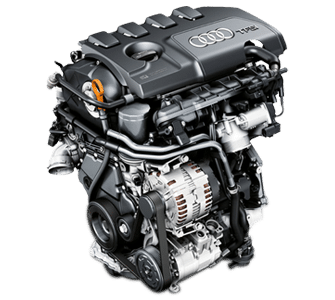What’s the difference between FSI and TSI ?

There have been some questions between the differences between the VW/Audi 2.0 liter FSI and TSI engines. I will try and highlight the differences between them to help you understand the evolution of the TSI powerplant from the TSI. I won’t be covering every difference, but I will try to go over the most significant differences.
Before we get too far into describing the differences I would like to clarify that TSI, FSI and TFSI have been used on varying models as marketing vernacular for VW/Audi. Just looking at the engine cover is not always a sure fire way to identify one from the other.
What does FSI and TSI stand for?
FSI is short for “fuel stratified injection” or “fuel straight injection” and TSI is short for “turbo stratified injection”. These are types of fuel injection systems that allow engines to run lean air-to-fuel ratios (better fuel economy) by creating a fuel rich “stratified charge” near the spark plug, but the side-effect is increased NOx (nitrogen oxide). Catalytic converters can remove the extra NOx, but the high sulfur content in U.S. fuel contaminates and destroys them. In Europe FSI engines use the lean burn for optimized power and economy, but the U.S. version uses the same air-to-fuel ratio as port-injected engines.
So, from this description we know that we are talking about a type of injection system, not an engine block. You will see in the modern VW/Audi lineup that TSI, FSI and TFSI are used on a range of engines such as the 3.0, 4.0, and 4.2 liter engines. What we are really looking at then when we are talking about the 2.0TSI and 2.0FSI are the differences between the EA113 engine code normally associated as the FSI, and the EA888 engine code normally associated as the TSI.
For the remainder of this article I am still going to refer to the differences between the FSI and TSI instead of the engine codes for the simple fact that it has become common practice to use them interchangeably for the EA113 and EA888 codes.
What is the same between FSI and TSI?
- Displacement: 1984cc
- Max Power: 200hp
- Max Torque: 206 lb ft
- Valves per Cylinder: 4
- Bore: 82.5mm
- Stroke: 92.8mm
- Firing Order: 1-3-4-2
What changed from the FSI to the TSI?
- Chain timing versus belt timing in the FSI
- Compression Ratio: 9.6:1 down from 10.5:1
- Engine Management: Bosch MED 17 from Bosch MED 9
- Oxygen Sensors: Addition of one for a total of 3, from 2
- Main bearing caps are now cross bolted to the block for additional strength.
- Oil spray jets to piston undersides for improved cooling and lubrication.
- More balanced cam shafts in the center of the block
- Improved fueling system running the HPFP (high pressure fuel pump) off of a dedicated lobe on the exhaust cam.
- Improved flowing cylinder head
- Updated internals with less internal parasitic loss
- Improved PCV system
From the list you can probably see that the TSI is a definite evolution from the FSI. There is a common misconception that the EA113 FSI is the more “tuner friendly” because VW released it in the premium Golf R. This was really the result of production and development timelines from VW, not strength and power limitations for the EA888 TSI. As the EA888 TSI platform progresses you will be seeing some incredible power out of the latest evolution of VW/Audi’s small displacement turbo platform.
